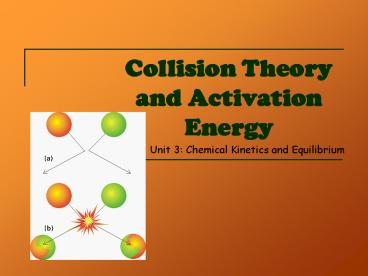Collision Theory and Activation Energy - PowerPoint PPT Presentation
1 / 23
Title: Collision Theory and Activation Energy
1
Collision Theory and Activation Energy
- Unit 3 Chemical Kinetics and Equilibrium
2
Review Chemical Reaction
- Generic Format of reaction
A B C D
Reactants
Products
5 different types of chemical reactions
1) Synthesis
4) Double Displacement
2) Decomposition
5) Combustion
3) Single Displacement
3
Review Kinetic Molecular Theory
- Used to explain many observations and chemical
events! - All matter is made up of microscopic-sized
particles (atoms, ions, molecules) - These particles are in constant motion (possess
kinetic energy) - There is space between the particles (speed and
spacing determine the physical state of matter) - Adding energy increases the speed of the moving
particles (thus inc kinetic energy)
4
How do reactions occur?
Collision Theory
- In order for a chemical reaction to take place,
the reactants must come in contact and
collide!!!!! - The collision transfers kinetic energy needed
to break the necessary bonds so that new bonds
can be formed.
5
Turns out
- By calculating how many collisions are taking
place per second and how quickly product is being
produced chemists learned that most collisions
are not successful (no product formed) - To think that reactant particles collide and
products are automatically produced is over
simplified. - There must be other requirements for a collision
to be successful!
6
The Collision Theory
- is an explanation of what is necessary for a
chemical reaction to occur. - When a chemical reaction takes place, the
reactant particles must meet two conditions (or
requirements) during collision for the collisions
to be successful - Proper orientation
- Particles must collide with a certain minimum
amount of energy, called activation energy.
7
1. Orientation
- Particles must collide with the proper geometry
or orientation for atoms to come in direct
contact and form the chemical bonds of the
products.
8
(No Transcript)
9
2. Activation Energy
- Particles must collide with a certain minimum
amount of energy, called activation energy (Ea). - This energy is required to break chemical bonds
in the reactants. - Note The energy of each particle is not
important, it is the energy of the collision.
10
2. Activation Energy
11
Effect of Temperature
12
Potential Energy Diagram
- We can represent the increase in potential energy
during a chemical reaction using a potential
energy diagram - The kinetic energy of reactants is transferred to
potential energy as the reactants collide
13
The hill
- The hill represents the activation energy that
must be overcome for the reaction to occur - high hill ? slow rate of reaction
- low hill ? fast rate of reaction
- Top of hill is called change over point
- There is a chemical species that exists here is
referred to as activated complex - Activated complex
- Neither reactant or product
- Partial bonds, highly unstable
14
- Potential Energy Diagram Handout
15
- If both of these conditions are not met,
particles will merely collide and bounce off one
another without forming products.
16
Some collisions are successful.
- Although, the percentage of successful collisions
is extremely small, chemical reactions still take
place at a reasonable rate because there are so
many collisions per second between reactant
particles!
17
Reaction Mechanism
- Converting reactants to products often involves
more then one stepas you know! - Each step is called an elementary reaction
- Molecules formed during elementary reactions are
called reaction intermediates (neither reactants
nor products) - Example 2NO O2 ? 2NO2
- Step 1 NO O2 ?NO3
- Step 2 NO3 NO ?2NO2
18
The Rate Determining Step
- In multi-step reactions there can be 2 or more
elementary reactions. - There is always one reaction that is slowest
this determines the overall rate of reaction - Thus, the slowest elementary reactions is called
the rate determining reaction.
19
Catalysts
- Works by lowering the activation energy of a
reaction so that a larger fraction of reactants
have sufficient energy to react - They do this by providing an alternative reaction
mechanism
20
For example
- A B ? AB (no catalyst)
- With catalyst
- Step 1 A catalyst ? A-cat
- Step 2 A-cat B ? AB catalyst
- Overall A B ? AB
- Both steps are faster then the original,
uncatalyzed reaction - Catalyst remains unchanged in the end
21
Catalysts contd
22
Real life catalyst example
- Manganese dioxide (a black powder) will catalyze
the breakdown of hydrogen peroxide. - 2H2O2 (aq) ? 2H2O(l) O2 (g) (uncatalyzed)
- With catalyst
- Car exhaust pipes use catalytic converters to get
rid of some of the nasty gases from the engines.
23
Practice
- Read Chapter 12!!!!!
- Pg 484 9, 12a,b,d
- Pg 486 1-4, 12































